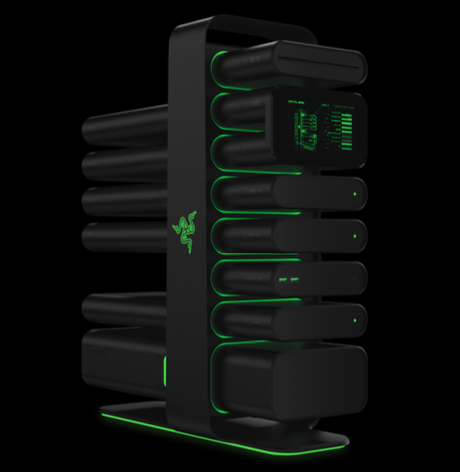A step into the future of computers

Project Christine looks different than any current computer. This design was made to make accessing and changing the computer easier for a larger group of people.
At the latest Consumer Electronics Show (CES) Razer unveiled their revolutionary idea for computer technology.
Project Christine (as Razer is code-naming it for now) is a new approach to how computers are structured and how they function. Instead of the classic tower design for desktops that everyone is familiar with, Project Christine is a modular system; you buy and plug in the computer components you want and it just works.
This system is much more friendly to the consumer as the assembly is quite simple. No longer do we need to toil with making sure every plug is in the right spot and thermal paste is applied correctly to the parts so they don’t overheat.
The maintenance of these new machines is simplified as well. On the front of Project Christine there is a screen that displays all the information about the system, just like the dashboard of a car. This includes temperatures of the system as well as performance levels and any relevant information to the program you are running.
Now while this all sounds fantastic there quite a few issues that come to mind: How expensive will this be? Who provides the parts for the system? Will the equipment stay current with PC’s or will it always be slightly behind?
The modules that Project Christine uses are completely unique to the system. Each module uses water to cool the components and must be built to work with the system. This means that the prices will have to be higher for each part to compensate. Buying parts for systems now can be quite expensive and with the requirements to work for Project Christine the price could jump out of reach of the average consumer.
Razer as a company doesn’t make hardware for computers. This means they need to buy the pieces from OEMs (original equipment makers) like Nvidia, Intel, AMD, etc. Right now these companies are able to sell straight to their consumers, which means they get a larger profit. However, I believe that these companies will want to sell to Razer as well because this could be the way computers go in the future. The earlier that they are able to join the market the better their future is secured. On the other hand, if these companies didn’t sell to Razer, then Razer would be forced to either design its own or give up altogether on Project Christine.
As mentioned earlier, the modules used for Project Christine are unique in how they work. This means they will take more time to perfect and get working properly. In turn that means it will take longer for Project Christine to get out the latest and greatest hardware to its users. While most people won’t mind being slightly behind, this could put off some of the more hardcore computer users that demand the best for their systems because they rely on them so much. Now this could all change, as Razer hasn’t said anything yet on how the process for obtaining their hardware will work or how much it will cost.
Ultimately, Project Christine is an intriguing step forward as its success or failure will influence the future of computers. If it succeeds it could make the world of computers easy to access for a lot of people.






